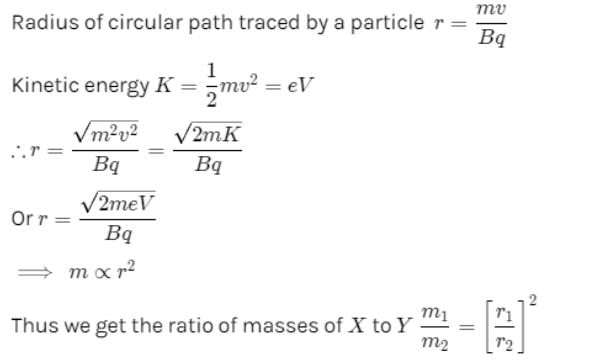QUIZ 3:motion Of A Charged Particle(#free Test Series) - JEE MCQ
15 Questions MCQ Test - QUIZ 3:motion Of A Charged Particle(#free Test Series)
A proton moving with a constant velocity passes through a region of space without any change in its velocity. If E→ and B→represent the electric and magnetic fields respectively, then this region of space may have [IIT-JEE 1985; AMU 1995; AFMC 2001; Roorkee 2000; AMU (Med.) 2000]
A uniform electric field and a uniform magnetic field are produced, pointed in the same direction. An electron is projected with its velocity pointing in the same direction [NCERT 1980; CBSE PMT 1993; JIPMER 1997; AIEEE 2005]
| 1 Crore+ students have signed up on EduRev. Have you? Download the App |
Two particles X and Y having equal charges, after being accelerated through the same potential difference, enter a region of uniform magnetic field and describes circular path of radius R1 and R2 respectively. The ratio of mass of X to that of Y is [IIT-JEE 1988; CBSE PMT1995; MP PMT 2001]
A beam of ions with velocity 2×105m/s enters normally into a uniform magnetic field of 4×10-2tesla. If the specific charge of the ion is 5×107C/kg, then the radius of the circular path described will be [NCERT 1983; BVP 2003]
The radius of curvature of the path of the charged particle in a uniform magnetic field is directly proportional to [MNR 1995; UPSEAT 1999, 2000]
An electron has mass 9×10-31kgand charge 1.6×10-19Cis moving with a velocity of 106m/s, enters a region where magnetic field exists. If it describes a circle of radius 0.10 m, the intensity of magnetic field must be [NCERT 1982; CPMT 1989; DCE 2005]
A proton (mass m and charge +e) and an α−particle (mass 4m and charge +2e) are projected with the same kinetic energy at right angles to the uniform magnetic field. Which one of the following statements will be true [NCERT 1983]
A charged particle moving in a magnetic field experiences a resultant force [MP PMT 1994]
If the direction of the initial velocity of the charged particle is perpendicular to the magnetic field, then the orbit will be or The path executed by a charged particle whose motion is perpendicular to magnetic field is [MP PMT 1993; CPMT 1996]
If the direction of the initial velocity of the charged particle is neither along nor perpendicular to that of the magnetic field, then the orbit will be [MP PET 1993]
Particles having positive charges occasionally come with high velocity from the sky towards the earth. On account of the magnetic field of earth, they would be deflected towards the [NCERT 1977]
A 2 MeV proton is moving perpendicular to a uniform magnetic field of 2.5 tesla. The force on the proton is [CPMT 1989]
A charged particle moves with velocity v in a uniform magnetic field B−→. The magnetic force experienced by the particle is [CBSE PMT 1990]
A proton is moving along Z-axis in a magnetic field. The magnetic field is along X-axis. The proton will experience a force along
A proton of mass m and charge +e is moving in a circular orbit in a magnetic field with energy 1 MeV. What should be the energy of α−particle (mass = 4m and charge = + 2e), so that it can revolve in the path of same radius [BHU 1997]


 The only force acting on the electron is electric force which reduces it?s speed.
The only force acting on the electron is electric force which reduces it?s speed.















